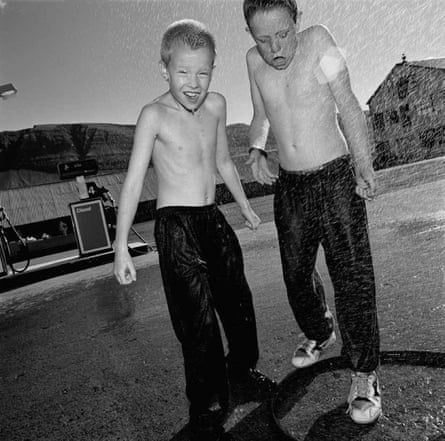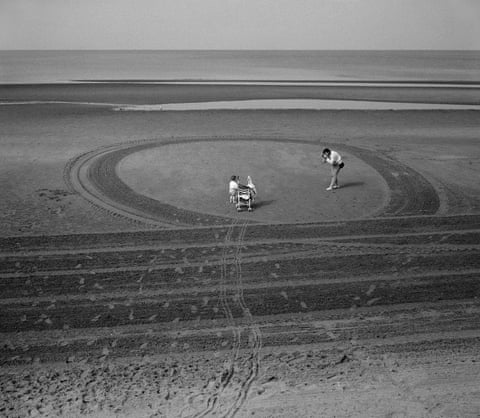Though the shipping forecast is still broadcast daily on BBC Radio 4, the strange resonance of what Seamus Heaney called “that strong gale-warning voice” may not, in an age of digital information overload, cast quite the same spell it once did on the collective imagination. It nevertheless remains a constant for many listeners, reassuring in its steadiness even as it gives notice of unruly swells and approaching storms in those faraway-sounding hinterlands of Dogger, Viking and German Bight.
“It occupies a deeply rooted place in our culture,” says Mark Power, whose book The Shipping Forecast comprises photographs from the 31 sea areas that are enumerated in the daily radio litany. “For many of us there is an essential mystery to the shipping forecast that perhaps comes from hearing it in the background as a child, but not really understanding it. And, even as we grow older, it’s difficult for most of us to understand it, because we’re not depending on it the way sailors or trawler crews depend on it.”

Shannon, Thursday 4 April 1996. Southerly 6 to gale 8, decreasing 4 in northwest. Occasional rain. Moderate or good.
The new edition of his book expands on the original, which was published in 1996 and became a surprise bestseller, as Power puts it wryly, “disappearing into countless suburban living rooms, where there were only a couple of photography books on the shelves”.
The idea for the project came to him in 1990, when he spotted a tea towel imprinted with a map of the 31 sea areas listed in the shipping forecast in the gift shop of the Royal National Lifeboat Institution in Great Yarmouth. Then, in late 1992, he began photographing around sea area Wight, which includes Brighton, where he still lives. Initially he approached the project with no real understanding of what it would entail in terms of the distances involved, though he did set himself some parameters. “I knew what I didn’t want to do, which was to make heroic or romantic pictures of man battling the elements at sea. Instead, I wanted to approach it from the point of view of an ordinary person, so I chose places that could be reached by public transport – bus, train and ferry.” The exceptions were the remote sea areas of Sole and Bailey, which he accessed by hitching rides on Met Office helicopters.

Thames, Sunday 7 January 1996 Southeasterly veering southwesterly 5 or 7. Rain, then showers. Moderate or poor, becoming good.
As the project progressed, he bought a camper van, travelling alone or with his wife for weeks at a time, usually in the summer break from his teaching job. “There were many dark moments of self-doubt,” he says, “but slowly, through doing it, the nature of the project began to reveal itself.”
He cites a mysterious image of a dark figure walking across a sandy beach towards some buildings that are partly obscured by a huge plume of smoke emanating from somewhere beyond the frame. “That was an important picture for me because it purposefully does not show what has happened. It does not explain itself. What I was trying to do throughout was to create beautiful but mysterious visual metaphors for the shipping forecast, for the peculiarity of the language of the actual broadcast. In a way, it’s the very opposite of photojournalism.”

Dover, Saturday 5 March 1994. Northeasterly 3 or 4, increasing 5, occasionally 6 later. Drizzle at first. Moderate or poor with fog patches, becoming good.
As with the original edition, each photograph in the new book is accompanied by the location – Thames, Bailey, Shannon, Rockall, Finisterre etc – and the 6am forecast for that area on the day the picture was made. The effect is slightly disorienting, even surreal, as with a shot of two bare-chested boys in tracksuit bottoms and trainers, bracing themselves against the cold spray of a petrol station hose. Taken somewhere in Iceland, the caption reads: “Southeasterly backing northeasterly 3 or 4. Occasional rain or drizzle. Moderate with fog patches.”
Elsewhere, there are brooding images of elemental emptiness – grey seas and even greyer skies – and subtle geometric landscapes that hint at the more formally rigorous conceptual thrust of Power’s later work.

Southeast Iceland, Saturday 10 August 1996. Southeasterly backing northeasterly 3 or 4. Occasional rain or drizzle. Moderate with fog patches.
The new edition adds 100 images to the original 63. Power tells me he was taken aback by what he calls “moments of complete blankness”, while re-editing the 14,000-plus photographs he made while on his epic voyage of discovery. “I realised that if it were not for the photographs, I would never have known I’d been to this Hebridean island,” he says of one image in the book of an old man standing, bent over, behind some austere buildings. “It was never about creating the definitive photograph of these places, it’s just fleeting impressions that in some way relate to the peculiar fascination of that mysterious voice on the radio.”

Tyne, Sunday 25 July 1993. West or southwest, 3 or 4 increasing 5 or 6. Showers. Good.








